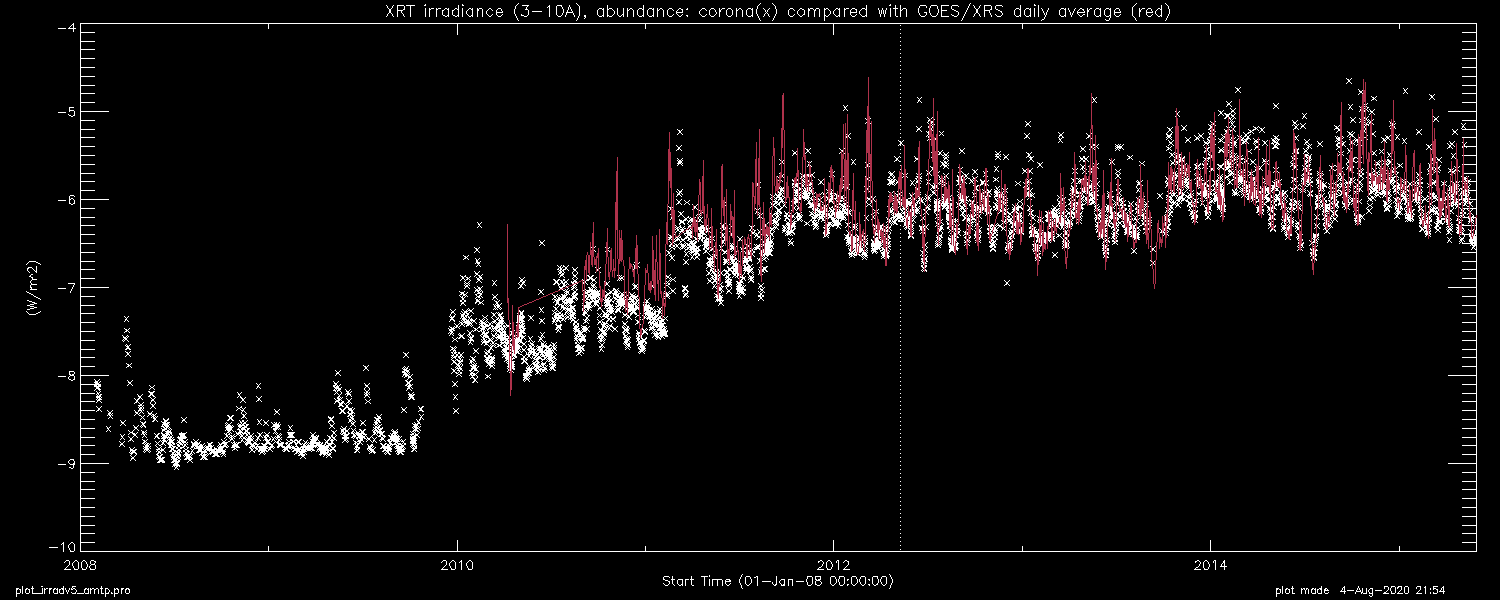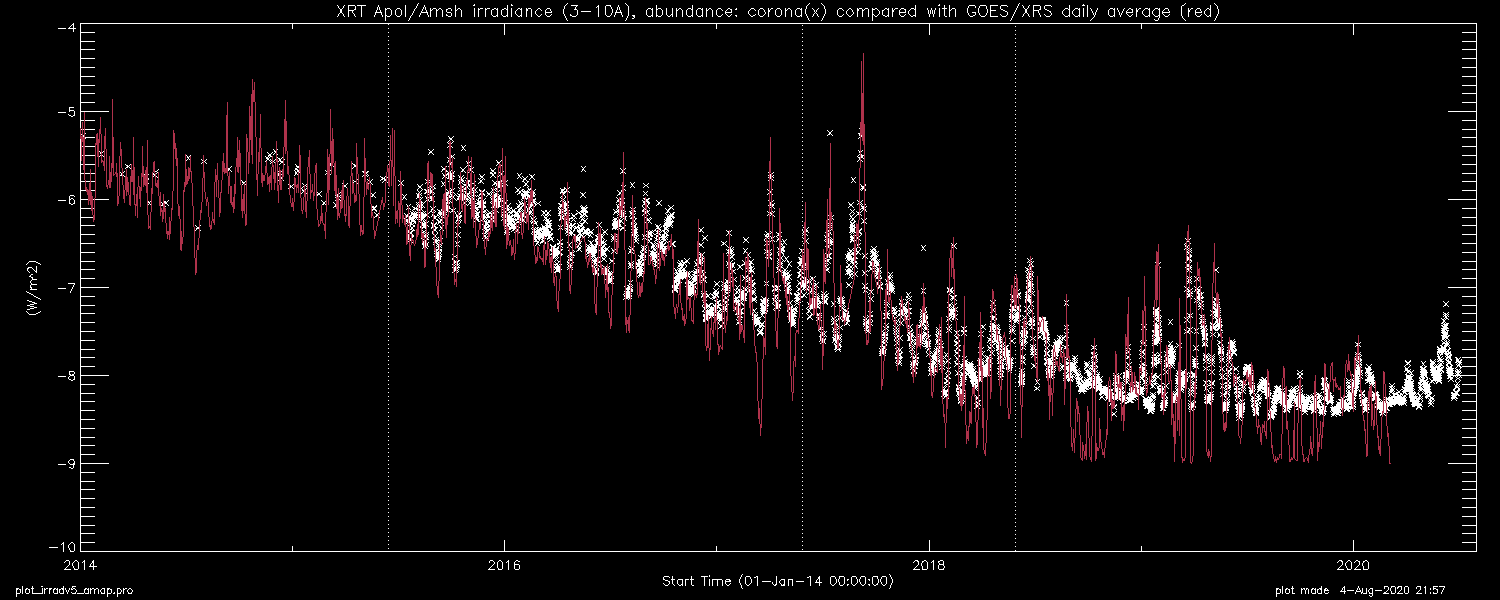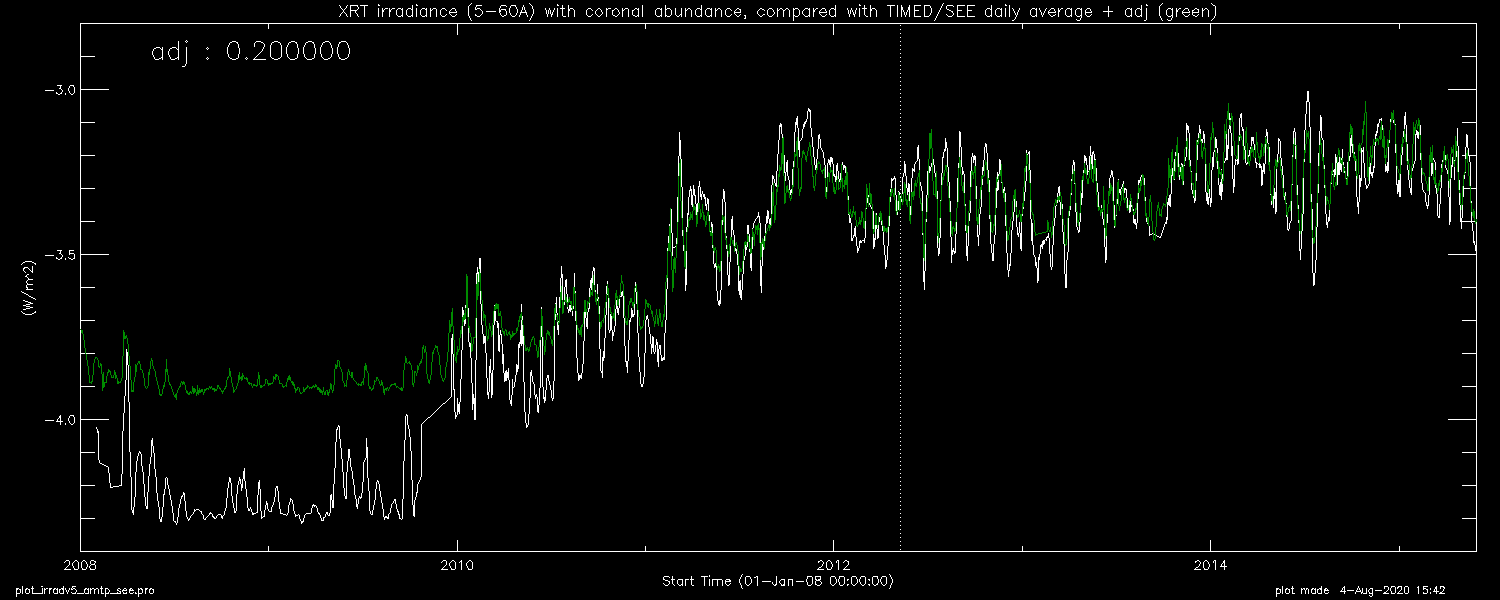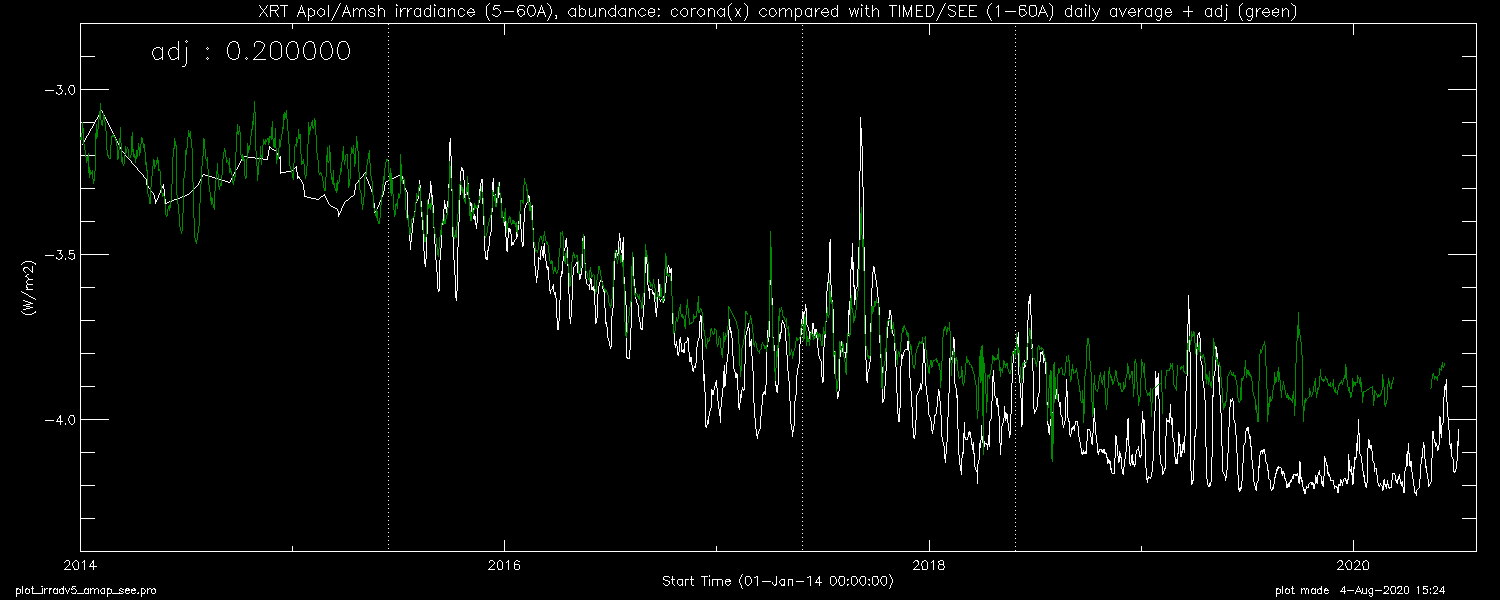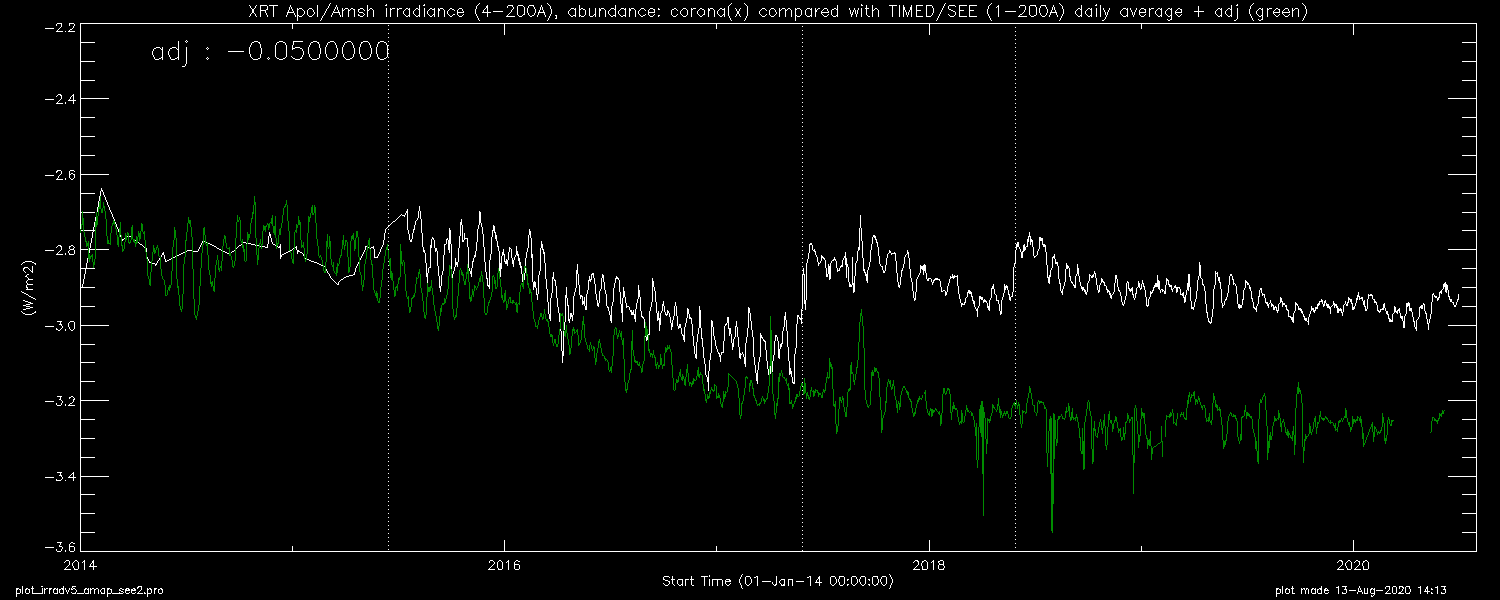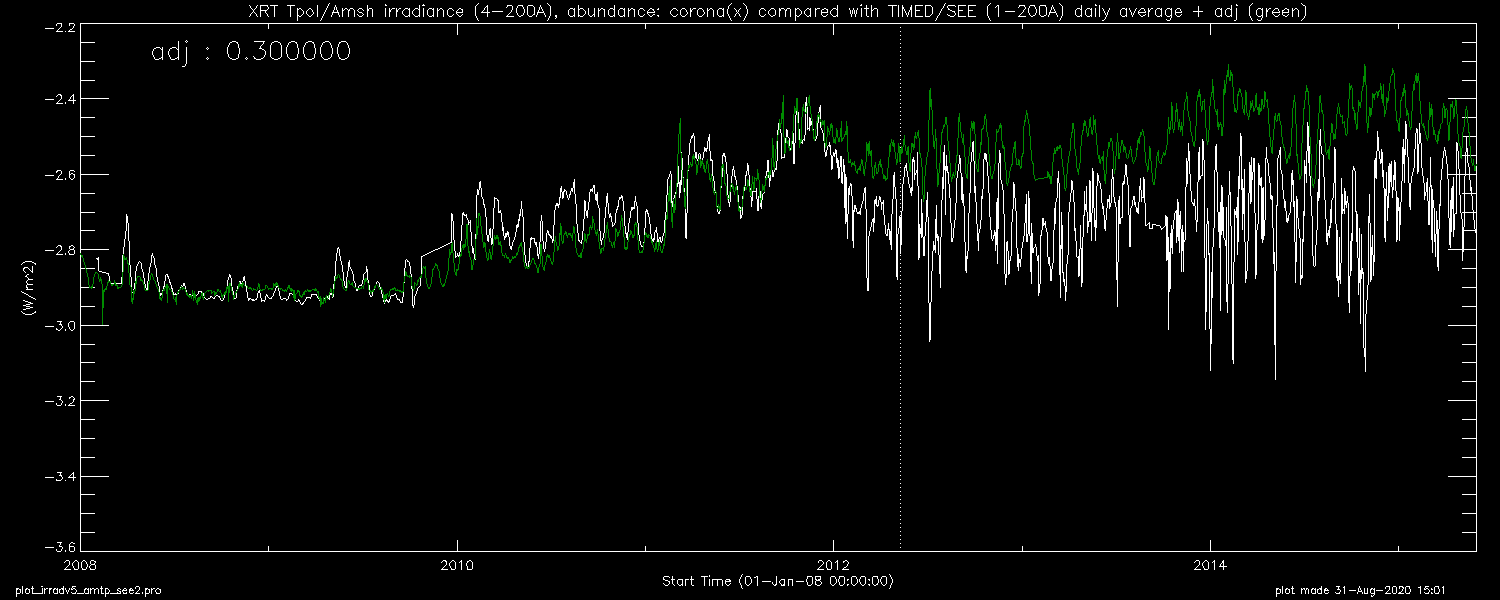Modification of Hinode/XRT temperature response functions
through full-disk XRT irradiance study
Aki Takeda as a project prepared for REU 2020
Project description
MSU is home of Hinode/XRT Synoptic Composite Image Archive (SCIA,
http://solar.physics.montana.edu/HINODE/XRT/SCIA/latest_month.html,
which is the archive of soft X-ray full-Sun images obtained with the
X-Ray Telescope aboard the Hinode satellite. Our images are posted
daily to the SolarMonitor,
a popular site for solar researchers to check the current solar condition.
We will process the XRT/SCIA images taken from 2007 to date to derive
solar soft X-ray irradiance during this period.
Just like all living creatures, XRT instruments are aging over more
than 12 years of operation in space. We should carefully separate the
variation of the solar signals from that caused by the characteristic
change of the instrument. We will use other source of soft X-ray
irradiance (GOES/XRS, TIMED/SEE) to calibrate XRT's temperature
response functions and to obtain reliable values of XRT irradiance.
MSU's REU program for 2020 summer was cancelled
due to the Covid-19 pandemic (announce made on 13 April),
and this means we became unable to work on this project with our
REU student (Kara Hokenstad from Whitworth University, WA).
However, this project contains some hot topic whose study should not
be postponed until the next REU opportunity in 2021 summer.
Therefore, we decided to turn this project into the one between
Suman Panda (co-mentor of my REU project) and myself to perform
during this summer (June and July, 2020).
We redefine the goal of our summer project as follows:
(1) Derive XRT soft X-ray irradiance from the XRT full-sun composite
images from 2008 through the most recent.
(2) By comparing them with other instruments (GOES/XRS, TIMED/SEE),
calibrate XRT's effective area function taking proper account of
the stray light contamination caused by the pre-filter failure.
XRT soft X-ray irradiance
- [step 1] find pairs of images taken within 5 minutes apart.
- 2007.1 - 2015.5 : Al_mesh and Ti_poly
- Ti_poly became unavailable due to stray light contamination
(since 14-Jun-2015).
- 2015.3 - present : Al_mesh and Al_poly
- Eliminate
pairs with bad images (missing frames, SAA, cosmic rays,
saturations, etc.)
- [step 2] collect signals of 1.10 R_sol from image pairs.
- [step 3] calculate filter ratio temperatures and emission measures.
- apply xrt_teem.pro
- elemental abundances : corona, hybrid & photospheric
- [step 4] calcualte soft X-ray isothermal spectrum with CHIANTI
ver.9.0.1 DB and SW, then convert them to irradiance.
- elemental abundances : corona, hybrid & photospheric
- wavelength range : 5-60A (XRT), 1-8A (for GOES)
IMPORTANT NOTE:
Since 2012 May, XRT started to suffer the visible stray light
contamination caused by a series of failures (appearance of small
openings) on the XRT pre-filter. The XRT irradiance derived with this
method is affected by the stray light in the following two ways:
(1) Subtraction of stray light image from each X-ray images.
(2) Modify XRT response functions (through effective area functions)
so that they reflect the contamination of the stray light.
While the correction of (1) is included in the process (step 2) of
irradiance calculation, (2) has not been considered in the previous
studies because there was no direct way to estimate the amount of
opening of the pre-filter. This project aims to provide the best
possible estimate of the amount and modification of the XRT
effective area functions and temperature response functions.
Important dates : pre-filter failure events
IDL> check_sl_phase()
--- phase 0 : 23-Oct-2006 10:00
--- phase 1 : 9-May-2012 12:00 --- 1st failure event
--- phase 2 : 14-Jun-2015 12:30 --- 2nd
--- phase 3 : 27-May-2017 11:00 --- 3rd
--- phase 4 : 29-May-2018 00:00 --- 4th
Compare with GOES/XRT
(work in 2015)
(work in 2019)
Ongoing irradiance work
(work in 2020)
GOES/XRS irradiances
GOES: The Geostationary Operational Environmental Satellite
XRS: X-Ray Sensor
Recent announcement from NCEI
Data access page
[table 2.]
Chronology of primary and secondary satellites for XRS measurements since 1986
------------------------------------------------------
Start Date Time Primary Secondary Remarks
------------------------------------------------------
2015-06-09 00:00 GOES-15 GOES-13 (AkT from SolarMonitor plots)
2015-05-21 00:00 GOES-14 GOES-13 (AkT from SolarMonitor plots)
2015-01-24 00:00 GOES-15 GOES-13 (AkT from SolarMonitor plots)
2012-11-19 16:31 GOES-15 None
2012-10-23 16:00 GOES-14 GOES-15
2011-09-01 0:00 GOES-15 GOES-14
2010-10-28 0:00 GOES-15 None
2010-09-01 0:00 GOES-14 GOES-15
2009-12-01 0:00 GOES-14 None GOES-10 decommissioned
2008-02-10 16:30 GOES-10 None GOES-11 XRS failure
2007-12-18 0:00 GOES-11 None GOES-10 not tracked due to antenna problems
2007-12-05 0:00 GOES-11 GOES-10
2007-11-21 0:00 GOES-11 None GOES-10 not tracked due to antenna problems
2007-04-12 0:00 GOES-11 GOES-10
2007-01-01 0:00 GOES-10 GOES-11
2006-06-28 0:00 GOES-12 GOES-11
2006-06-22 14:00 GOES-12 None
------------------------------------------------------
TIMED/SEE irradiances
TIMED: Thermosphere Ionosphere Mesosphere Energetics and Dynamics
SEE: Solar EUV Experiment
data access page
Weekly goals (2020)
- Week 1 (6/4 -- 6/11) : XRT irradiance recalculation (2017-present), Solar minimum study (2008 and 2019) (A).
Preparation of GOES/XRS science quality daily averaged data (2009-present) (S).
- Week 2 (6/11 -- 6/18) : Prepare codes to calculate effective area
functions and XRT flux modified with assumed values of pre-filter openings. (A).
Download scientific GOES 14-15 data from NGDC and made them into daily
averaged data connected for 2010-2020. (S)
- Week 3 (6/18 -- 6/25) : Prepare XRT irradiance data for 2012-May with different stray light assumptions.(A).
Recalculation of GOES data and preparation of TIMED/SEE processing.(S)
- Week 4 (6/25 -- 7/2) : Investigate 1st pre-filter failure event (May-2012).
The period of consideration expanded to the whole 2012.(A). Preparation of
TIMED/SEE daily flux. Confirmed the wavelength ranges as 1-10A and 1-60A.(S)
- Week 5 (7/2 -- 7/9) : no meeting because of Suman's summer school.
- Week 6 (7/9 -- 7/16) : no meeting because of XRT duty week &
Suman's summer school.
- Week 7 (7/16 -- 7/23) : XRT irradiance period for 1st pre-filter event
expanded to 2008/02 -- 2015/05. Elemental abundance changed to 'coronal'.(A)
Prepared SEE's 1-60A daily data for 2012-2020.(S)
- Week 8 (7/23 -- 7/30) : XRT irradiance 5-60A with coronal abundance was
compared with TIMED/SEE.(A) Refinement of GOES and TIMED data products.(S)
- Week 9 (7/30 -- 8/6) : Break for Suman's exam.
- Week 10 (8/6 -- 8/13) : XRT irradiance 4-200A was compared with TIMED/SEE.(A). Preparation of final products of GOES and TIMED data for local archive (S).
Results
We calculated the XRT irradiance from full-Sun integrated filter-ratio
temperatures and emission measures, and compared with the X-ray flux
observed by GOES/XRS(1-8A) and TIMED/SEE(1-60A and 1-200A).
-
Hinode/XRT irradiance calculated for 3-10A and GOES/XRS (Jan-2014 to May-2020).
--- before/after the 2nd(14-Jun-2015), the 3rd(27-May-2017) and
the 4th(29-May-2018) pre-filter failure events.
Plots after pre-filter open fraction considered.
2015 XRT irradiance (3-10A)
with stray light modification
Resources
